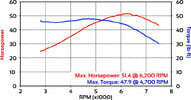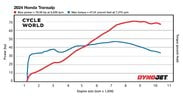senecagreen
Member
I just read a comparison between the Transalp 750 vs Tiger 850 vs V Strom 800 RE. The biggest complaint about the Honda was you had to rev it to get decent power out of it as they stated compared to the Suzuki and Triumph it noticeably lacked low and midrange power which is what they were looking for in a adventure bike.
I thought the only thing the NC750Xlacks is top end as it levels off right after 6000 rpm. So I looked up the dyno charts and hp wise the NC is right there with the Transalp to 6000 but starts with lots more torque on bottom and maintains it to an equal peak but at a lot lower peak rpm.
I really like the NC powerband and shifting at 6000 when you ride it agressively is no big deal to me as I rode Harleys for years and on the twin cams you shifted at 5000 anyway.
If the Transalp had the bottom end of the NC it probably would have fared better in the comparison.


I thought the only thing the NC750Xlacks is top end as it levels off right after 6000 rpm. So I looked up the dyno charts and hp wise the NC is right there with the Transalp to 6000 but starts with lots more torque on bottom and maintains it to an equal peak but at a lot lower peak rpm.
I really like the NC powerband and shifting at 6000 when you ride it agressively is no big deal to me as I rode Harleys for years and on the twin cams you shifted at 5000 anyway.
If the Transalp had the bottom end of the NC it probably would have fared better in the comparison.




